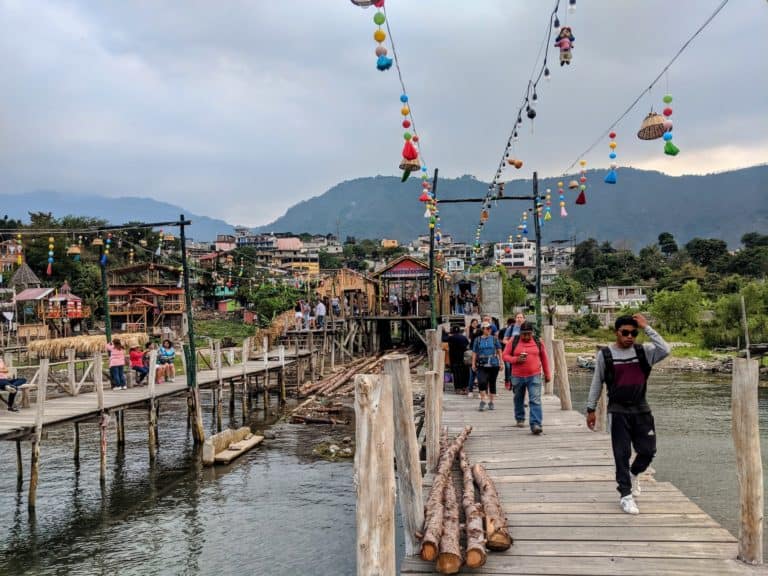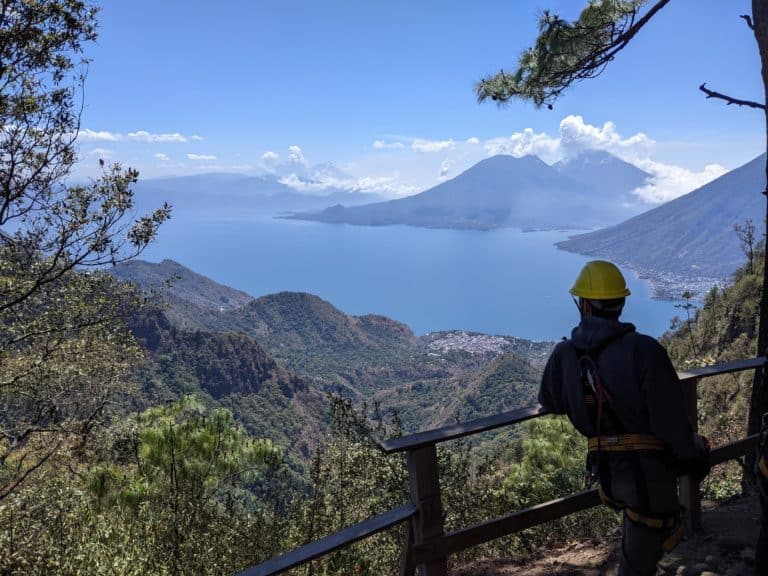Volcán San Pedro Hike – Risks & Rewards
Are you looking into the Volcan San Pedro hike? If so, you’ve come to the right place. In this post, I’ll cover everything you need to know about this hike, including the big ticket item: safety! Yup, that’s the number one consideration when it comes to hiking this volcano… as you’ve probably discovered if you’ve done the least bit of googling. I have good tips for you on how to mitigate the risks.
Next, I’ll go into how to get to San Pedro, how to get to the trailhead, what to take with you, and what to expect during the hike itself. I’ll finish off with some great facts about the San Pedro volcano.
Let’s dive in!
***This page contains affiliate links, so if you book a tour through those links, I’ll earn a small commission at no extra cost to you. Learn more in my disclaimer.***
What is the Volcan San Pedro hike?

San Pedro is the name of the smallest volcano on the shores of Lake Atitlán. This lovely and iconic stratovolcano is 9,908 feet (3,020 meters) high and offers spectacular views of the lake.
The hike itself traverses a steep climb through coffee fields and oak and pine forests. Birds trill in the trees and wildflowers adorn the path. Along the trail, you’ll pass the San Pedro lookout, a tire swing, and a campground.
From the top, you can see all but two of the towns nestled along the shores, as well as Sololá and the plateau behind it. The town of Santiago and its island-dotted bay, are a stunning 4,800 feet drop below.
Tolimán and Atitlán volcanoes are visible in all their glory to the southeast. Acatenango and Fuego volcanoes rise above the eastern ridge, while to the west you can sometimes see the top of Santa María volcano.
Is the San Pedro hike worth doing?

I have climbed San Pedro volcano two times. The first time was a fiasco, and the second a smashing success.
The first time I climbed San Pedro, a group of friends and I bushwhacked our way up the east flank and emerged on a completely forested peak. We couldn’t see anything. All this to avoid the entrance fees. Don’t make the same mistake!
The second time, a friend and I climbed the official trail… which was beautifully maintained. When I got to the top and saw the view, I literally gasped… and I’ve done my share of Guatemala volcano hikes. I’ve also seen Lake Atitlán from pretty much every angle. But wow. Not that angle. Not that view.
Yes, it is worth it!
Is the Volcan San Pedro hike safe?

Many of Guatemala’s lesser–climbed volcanoes are hotbeds for robberies, and San Pedro volcano is no exception. In fact, it’s one of the more infamous cases, probably because it gets a fair number of visitors.
Some volcanoes which used to be super dangerous (like Pacaya and Acatenango) are now well–managed and super safe. Unfortunately, San Pedro isn’t there yet.
Recent Holdups
The day I did the Volcan San Pedro hike, there had been a holdup two days before. Before that, there had been no holdups for nine months.
Updates:
January 2025 – According to a local source, the situation on San Pedro has improved and groups were climbing it safely.
Police Patrols on San Pedro Volcano

The municipality is in charge of the park and the volcano. They assign four policemen to the trail daily. Two of them hang out by the tire swing and the other two meander up the trail and back. According to the police I talked to, they are on duty daily from about 5 am to 5 pm.
It’s great that the municipality has put forth some effort, even if it isn’t super effective. (How hard can it be to avoid four policemen who follow the exact same procedure and hang out in the same spots every day?)
The level of effort exerted by the municipality can vary depending on who was elected and what their priorities are. That’s why there are times when safety seems to be better and times when it is worse.
Check-in Calls from Entrance Agent
When I did the Volcan San Pedro hike, my friend and I signed it at the gate, and the agent there took down my name and phone number. He called a couple of times during the hike to check in with us and see how we were doing and where we were.
I also heard a guide with another group talking to the agent. I don’t know if this is standard practice or not.

Part of me appreciated his phone calls and that he was checking up on us. The cynical part of me hoped he was honest and not in cahoots with the robbers. Since nothing happened to us, and since the agent works for the municipality, it seems he is worthy of trust.
San Pedro Volcano Hike Robbery – What You Need To Know
If you choose to do the San Pedro Volcano Hike, know that there is a possibility you will be robbed. Follow these tips to mitigate the risks.
1. Ask Locals about Current Safety Conditions
Before you decide to hike the volcano, ask around about the safety. Find out when the last holdups were, if there have been a lot in recent days, or if things have been pretty quiet.
You can also ask at the entrance, as the agent there is likely to have the most up-to-date and accurate information.
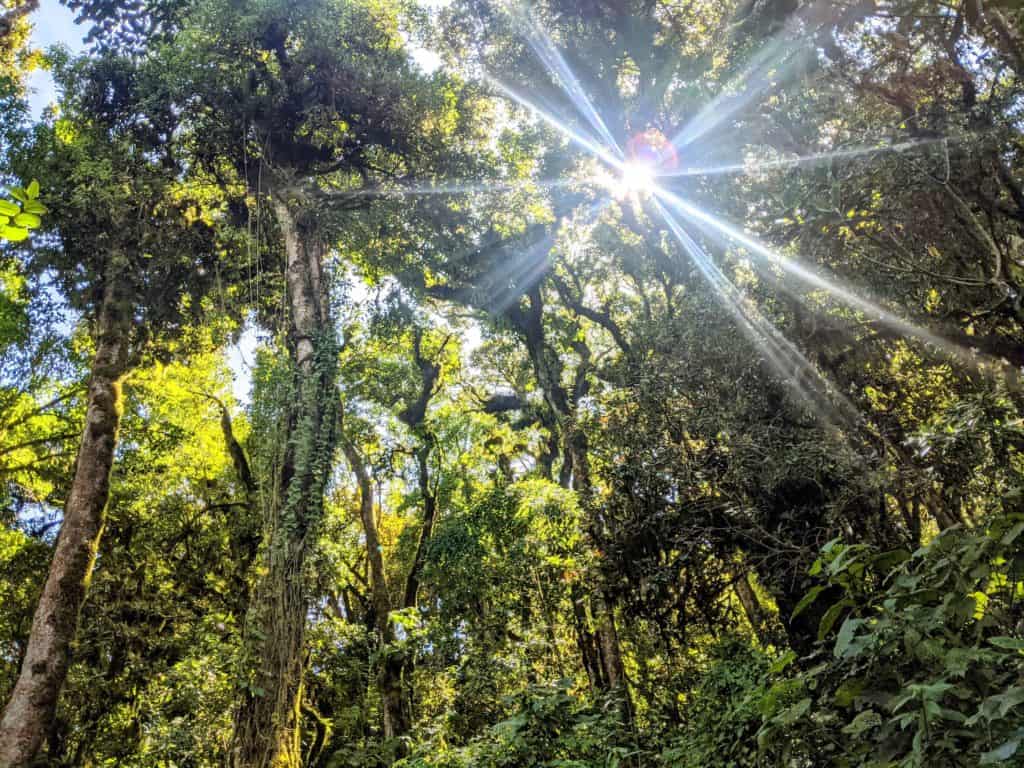
2. Pro Tip: Request a Tourism Police Escort 72 Hours Prior to Hike
One option I haven’t yet tried myself but could be a big help, is to get a tourism police escort. Since Guatemala has limited resources, you are responsible for providing for the agents while they are with you (food, gas, hotels — if applicable).
The idea is that the agents will stay with you and ensure your safety during the outing.
To request an escort during an outing, you can either call 1500 (the agents speak English), or fill out the tourist police escort request form. You must fill it out 72 hours before the hike/outing.
This service is provided by Guatemala’s Tourism Institute (INGUAT).
3. Do Not Take Valuables
Don’t take any valuables with you on the hike, or at least try to severely limit what you take. Don’t take a lot of money or expensive camera equipment with you. Remove all your jewelry, expensive watches, fitness trackers, etc.
Basically, don’t take anything you wouldn’t be okay to lose!
When I went, I took my phone, the money I figured I’d need for the day, plus some extra, and then the essentials: food, water, and a light jacket.
4. Hide Valuables Before Reaching 2800 meters

If you do have valuables with you, one tip I got from a pro hiking friend is to hide them inside a plastic bag somewhere around 2,800 feet. You want to make sure you can find the hiding spot again, of course!
Why hide them there? According to the man at the entrance, a lot of the robberies take place at the summit. I don’t know if this is true, since one of the policemen I spoke to told me there is no pattern to the hold-ups.
However, it does seem like a fair number of the robberies take place about 2,800 meters.
5. If Robbed, Do Not Resist
Getting robbed sucks majorly, and I sincerely hope it doesn’t happen to you.
Not only does it ruin what could have been an awesome experience, but it is also a financial hit. It’s a pain to replace the things that get stolen. But they can be replaced. Your life, on the other hand, is irreplaceable.
You can’t know how you’ll react if you are robbed, but if possible, try to pre-decide to just hand over your stuff. Usually, that is all they want. If you resist, things may get violent, and to me, that is just not worth it. Do everything you can to avoid escalating the situation.
This is my own personal opinion, so take it or leave it. You are responsible for your own decisions.
How to get to San Pedro Volcano from Panajachel

If you are not already in San Pedro but would like to hike starting from Panajachel or another town around the lake, this is the section for you.
My friend and I started from Panajachel. We went to the Tzanjuyú docks. We said we were going to San Pedro and were directed to the correct public boat. After a short wait, the boat headed out.
The first public boat to San Pedro leaves Panajachel around 7 am.
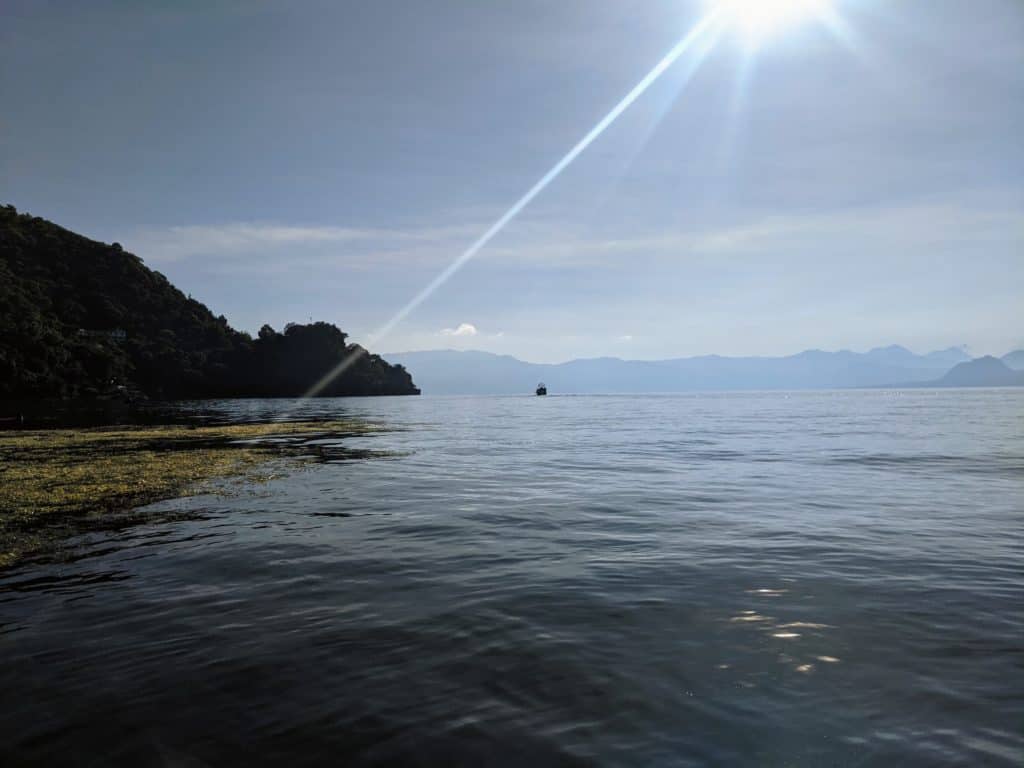

Since the boat will make multiple stops along the way (stopping at minimum at the main docks in Santa Cruz, Jaibalito, Tzununá, San Marcos, San Pablo, and San Juan), expect this portion of the trip to take about 1 hour. (It took us longer because our boat had issues and had to be towed.)
If you are staying in any of those towns, head down to the dock and get on when the boat makes its stop.
Cost: The boat should cost no more than Q25 for foreigners. The best bet is simply to hand over the exact amount when you reach your destination.
How to get to the San Pedro hike trailhead
Once you reach San Pedro, you can either walk to the trailhead or take a moto-taxi (tuc tuc).
From the boat launch, the entrance is 1.5 miles (2.4 kilometers) up a very steep hill. If you choose to walk, it could take 45 minutes.
When I went, my friend and I had no desire to spend an extra hour walking, so we caught a tuc tuc. Since gas prices were high when we went, we had to pay Q15 per person for the tuc tuc. The ride took 8-10 minutes.
Volcan San Pedro Hike – What to Expect
Once you get to the trailhead, you’ll need to pay the entrance fee and sign in. You can also use the bathroom and look at the informative signs about what animals and trees are present on the volcano (which is also an eco-park).
If you decide to hike super early or super late, you can pay on your way out of the park.
There are four major attractions along the way:
The San Pedro lookout

The first major stopping place you’ll encounter on your Volcan San Pedro hike is a two-story lookout. This structure offers a gorgeous view of the towns of San Pedro, San Juan (also worth a visit!), and San Pablo la Laguna.
You’ll also have a beautiful view of the Indian Nose/Mayan face, one of the top hikes I feature in my article about the best things to do in Lake Atitlán.
This is a good spot to use the latrine if you need it.
The tire swing

Shortly after the San Pedro lookout, you’ll come to the tire swing or the “columpio”. Sit on the swing, put your legs straight in front of you, and let loose. Wooo! The views are incredible.
I found it a bit hard to stop swinging once I’d started, but a friendly policeman came to the rescue.
The campground
After the tire swing, you’ll have to hike quite a long way (almost 900 meters) to reach the campground. There isn’t much here except for a run-down cabin and a couple of latrines.
Keep hiking down a small rise, and then along a gorgeous wooded ridge to reach the peak.
The peak

You’ll know you’re almost to the peak when you go up some wooden steps. Then you’ll reach a pile of massive boulders. Congrats! You’ve made it to the top! You can clamber over the boulders, take pictures, and enjoy an amazing picnic lunch.
My friend and I spend an hour at the top, just drinking in the amazing views and breathing clean crisp air. A true delight.
How much does it cost to hike San Pedro Volcano?
San Pedro Volcano costs:
Q25 for Guatemalans with a Sololá DPI
Q50 for Guatemalans from other departments
Q100 for foreigners
San Pedro is a bit pricey as far as volcanoes go. The entrance fee costs twice as much for tourists compared to the fee at Acatenango Volcano. That said, I think it is worth it for the views.
I know it is frustrating for tourists to have to pay so much more than locals, especially if you’re traveling on a budget. However, I personally like this system because it ensures that Guatemala’s national treasures are still accessible to Guatemalans.

Not only that, the municipality clearly puts in a lot of work maintaining the San Pedro volcano hiking trail. It was clear of debris and trash. I also really appreciated having access to the latrines.
(Want to climb another volcano? Check out my Acatenango hike guide, or go straight to finding the best Acatenango hike tours).
What to pack on the Volcan San Pedro Hike
Due to safety concerns, I don’t recommend camping on San Pedro volcano. However, a day trip is more manageable.
What I took when I climbed San Pedro Volcano:
- Breakfast & Lunch
- Plenty of water (I drink a lot, so I took 2 liters – enough to share with my dog)
- Wicking long-sleeve layer (it gets chilly on the top if you sit a while)
- Rain jacket/Windbreaker
- ID
- Money
- Phone
- External Battery for my phone*
- Hat (though I barely used it)
- Toilet Paper/One-Wipe Charlies
- Hand sanitizer
- First Aid Kit with a headlamp and tactical knife*
- Food and a water dish for my dog
- Sunscreen
* Overkill maybe, but it beats coming down a volcano in the dark with no cell phone and no light if things take longer than you expect. Been there, done that, and would rather not do it again.
When is the best time to do the Volcan San Pedro Hike?
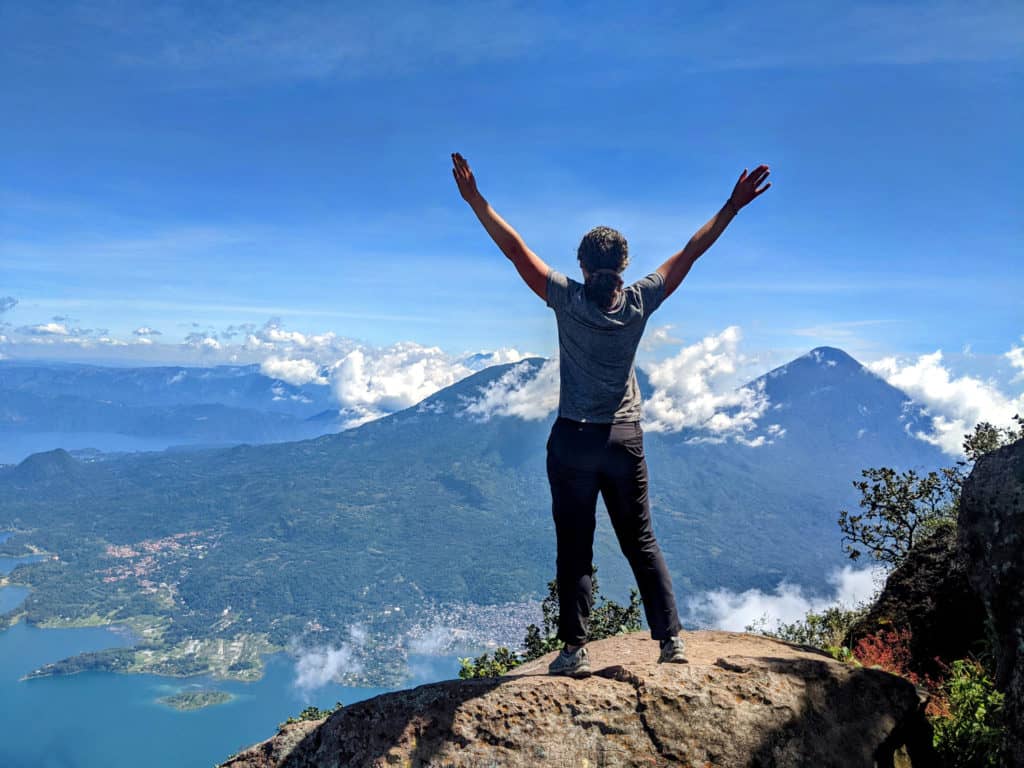
Although you can hike San Pedro volcano during the rainy season (May to October), you might end up hiking in the rain, or not get good views. It’s possible you’ll get lucky, though, especially if you hike early in the morning.
The best time to do any Guatemala volcano hike is from mid-November to March. The weather is usually dry and clear with excellent visibility.
March and April are still dry, but it can get so hazy that you might not be able to see anything.
Volcán San Pedro Hike FAQs

Have other things you’d like to know about this Lake Atitlan volcano hike? Read on for frequently asked questions about Volcán San Pedro.
How long does it take to hike Volcan San Pedro?
If you only count moving time, San Pedro volcano took me 3 hours total to climb, however, my friend and I made several long stops. On the way up, we ate a leisurely breakfast at the lookout. We also stopped for a long chat with the policemen at the “columpio” before trying out the tire swing for ourselves. We spent an hour at the top, then walked back down again.
Including stops, the hike us took us 3 hours and 20 minutes, and the hike down 2 hours. Faster hikers can make it up in 2 hours or less and down in 1.
How hard is the Volcán San Pedro hike?

San Pedro is a volcano, so it is a moderate-to-hard hike depending on your level of fitness. Expect it to be steep. However, the trail is well-maintained and is dirt for most of it. You should have decent traction. The switchbacks also make it an easier climb, since you aren’t going straight up the side.
I tracked my hike on Strava. Round-trip, the hike was 7 miles (11.42 km) with 4,009 feet (1,222 m) of elevation gain.
Does the Volcan San Pedro Hike include a guide?
When my friend and I hiked San Pedro volcano in October 2022, we were not offered a guide. The agent at the entrance explained that the trail is very well marked and we wouldn’t get lost. This was true.

At the beginning of the hike, all you have to do is follow the signs that say “volcán,” the white-painted rocks, and the yellow arrows. Later in the hike, where there’s less opportunity for confusion, there are some tags on the trees and elevation markers.
Should I hire a guide to hike San Pedro Volcano?
You may want to consider hiring a guide if it will help you feel more secure. Some guides are quite knowledgeable about the flora and fauna and can share interesting cultural information during the hike. This can make the journey more enjoyable.
When I went, the trail was very clearly marked, so I didn’t feel the need for a guide. There was very little risk of getting lost.

If you are thinking of hiring a guide for the sake of security, I recommend getting a tourism police escort instead. The tourist police should be bilingual and can be assigned to accompany you on your hike. In exchange, you will need to provide them with food, water, and possibly some gas money.
As I mentioned in the security section above, you can request an escort by calling 1500 (the agents speak English), or by filling out this online tourist police escort request form.
Of course, requesting an escort doesn’t mean you’ll necessarily get one. It depends on supply and demand.
Is Volcán San Pedro active?
No, San Pedro Volcano is not active. In fact, it is considered extinct. It is the oldest volcano in Atitlán. It is more eroded, has more vegetation, and has no fumaroles (vents from which hot gasses escape).
If you would like to get close to an active volcano, consider climbing Acatenango. You’ll have amazing views of Guatemala’s active Fuego volcano (and can potentially climb it as well via the saddle ridge).
Where is the San Pedro volcano?


San Pedro volcano is on the southwestern shore of Lake Atitlán, in the western highlands of Guatemala. It is in the department of Sololá and the municipality of San Pedro la Laguna.
San Pedro Volcano last eruption date
According to Volcano Discover, San Pedro Volcano has not had an eruption for the past 10,000 years.
How tall is Volcán San Pedro?
San Pedro Volcano is 9,908 feet (3020 m) tall. The crater is shallow and has a breach on its northwestern side.

Volcan San Pedro Hike – Final Thoughts
Although there are risks involved in doing the Volcan San Pedro, the views from the top are spectacular. I loved doing this hike! I hope that if you go, you have a great time as well! Just be sure to check with locals about current safety conditions.
Looking for more things to do in the area? Start off with these amazing things to do in Lake Atitlán, visit the magical town of San Juan la Laguna, or enjoy a slew of activities in Santa Cruz la Laguna. You can also go on a motorcycle tour, or visit some fun and cheap ziplines.
For community tourism, nothing beats a cultural visit to the community of Panimatzalam.
Want to hike more volcanoes? Check out my all-you-need-to-know guide to hiking Acatenango, or go straight to choosing the best Acatenango hike tour company. Or, for even more fun, choose one of these tours to Pacaya Volcano from Antigua.
***GUATEMALA TRAVEL PLANNING GUIDE***
Should I buy Guatemala travel insurance?
YES — Personally, I always travel with travel insurance because it gives me extra peace of mind. SafetyWing is an excellent travel insurance company that’s quite affordable. Plus, if you travel longterm, it’s a snap to renew on a month to month basis. You can keep renewing for up to a year and still pay the same deductible.
Where’s the best place for finding cheap flights to Guatemala?
When I purchase a ticket, I always search several different sites. Kayak and Expedia are great places to start running a search. Spirit is usually the cheapest carrier, but American Airlines and United also sometimes offer excellent deals.
What’s the best way to book my Guatemala accommodations?
I recommend booking.com for finding and booking hotels in Guatemala. For vacation rentals, I recommend VRBO.com — it offers beautiful and unique spots to stay.
What’s the best way to book Guatemala tours?
Viator is a great tour booking site with several excellent options available in Guatemala’s main tourist areas including Tikal, Atitlán, Antigua, and Acatenango. There’s a nice range of prices and options available.
Can you drink the water in Guatemala?
No – Don’t drink the tap water! Instead, buy purified water from any corner store or grocery store in Guatemala.
Be sure to brush your teeth with that water as well to avoid getting sick. And hydrated, especially when traveling to high elevations.
Do I need a visa for Guatemala?
Probably not — Visitors to Guatemala from “Category A” countries like the United States, Canada, the UK, New Zealand, Australia, and most European countries are automatically given a 90-day tourist visa (in the form of a passport stamp) when entering Guatemala.
This visa is valid for Guatemala, Nicaragua, Honduras, and El Salvador. At the end of 90 days, it can be renewed once at Guatemala’s Migración without leaving the country.
After 180 days, you will have to travel outside of Central America before returning. Check to see if you need a visa.
Will my phone work in Guatemala?
It’s possible, but check with your provider in advance to see if Guatemala is covered. If not, you can easily pick up a local SIM card.
There are essentially only two carriers in the country: TIGO and CLARO. Both have good coverage.

